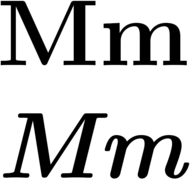m
 | ||||||||
| ||||||||
 | ||||||||
| ||||||||
| ||||||||
| ||||||||
Translingual
Etymology 1

See also
Etymology 2
Various abbreviations.
Pronunciation
IPA (file)
Symbol
m
- meter (metre), the unit of length in the International System of Units
- milli-
- (phonetics) used in the International Phonetic Alphabet and in several romanization systems of non-Latin scripts to represent the bilabial nasal (/m/), including Cyrillic м (m, “em”), the beginning of various kana including ま (ma), and Korean jamo ㅁ (m, “mieum”).
- mass
- month or months
- (music) mezzo, as in mezzo piano and mezzo forte
- million (since mid-20th century)
- thousand
- 1798 Letter from w:William Short (American ambassador) to Thomas Jefferson
- Having made a divorce with politics as I have already mentioned I have only to trouble you on my personal affairs ... —The principle & most pressing is that of the 9. m. dollars—
- 1798 Letter from w:William Short (American ambassador) to Thomas Jefferson
Etymology 3
From upper case roman numeral M (1000), an alteration of ⋈, from ∞, an alteration of ↀ, an alteration of Ⓧ, from encircling X (the roman numeral for ten) to indicate the hundredth ten.
Numeral
m (lower case roman numeral, upper case M)
- (Roman numerals) The cardinal number one thousand (1000).
Synonyms
Gallery
- Letter styles
 Capital and lowercase versions of M, in normal and italic type
Capital and lowercase versions of M, in normal and italic type Uppercase and lowercase M in Fraktur
Uppercase and lowercase M in Fraktur
See also
Other representations of M:
English
Etymology 1
Pronunciation
- IPA(key): /ɛm/
Audio (US) (file) Audio (UK) (file)
Letter
See also
Number
m (lower case, upper case M)
- The ordinal number thirteenth, derived from this letter of the English alphabet, called em and written in the Latin script.
Etymology 2
Noun
m (plural ms)
- Abbreviation of meter.
- Abbreviation of mile.
- Abbreviation of month.
- Abbreviation of minute.
- 1908, Francis Ernest Lloyd, The Physiology of Stomata (Carnegie Institution of Washington), page 83:
- Another instance: 2h28m p. m., 10 micra; 3h08m p. m., 0 micra; irrigated with water: 3h09m p. m., 4 micra.
- 1908, Francis Ernest Lloyd, The Physiology of Stomata (Carnegie Institution of Washington), page 83:
- Abbreviation of million.
- (music) Abbreviation of measure.
- (obsolete) thousand
- 1798 Letter from w:William Short (American ambassador) to Thomas Jefferson
- Having made a divorce with politics as I have already mentioned I have only to trouble you on my personal affairs ... —The principle & most pressing is that of the 9. m. dollars—
- 1798 Letter from w:William Short (American ambassador) to Thomas Jefferson
Verb
m
Egyptian
Etymology 1
Often suggested to be cognate to Hebrew בְּ־ (bə-), Arabic بِـ (bi-); however, more recent scholarship disputes this on phonological grounds, as Egyptian m is not held to regularly correspond with Semitic *b by either the traditional school of Egyptian comparison or the neuere Komparatistik school.
Pronunciation
- (reconstructed Old Egyptian) IPA(key): /ma/[1]
- (modern Egyptological) IPA(key): /ɛm/
- Conventional anglicization: em
Preposition
- in
- (of time) in, for, during
- (with certain verbs of motion) into
- (with most verbs of motion) from within, out of, from
- (of material) made of, consisting of
- (of contents, e.g. of a group) consisting of, comprising
- by means of
- in a state of
- in the capacity of, in the role of, as, being
- (with following infinitive) forms the periphrastic imperfective of a verb
Usage notes
This preposition is often used with the second last definition here to indicate temporary identity, so, for example, z m ꜣhw (“the man is a poor man”) implies that this a temporary, rather than an eternal or generally true, state. Egyptian generally has an expansive view of what counts as a temporary identity compared to English.
Inflection
Alternative forms
| m |
When the object of the preposition is an attached suffix pronoun, the adverbial form jm is used instead.
Derived terms
- ꜣst-m-ꜣḫ-bjt
- jj-m-ḥtp
- jw-m-jtrw
- jm
- jmj
- jmn-m-ḥꜣt
- wꜣḥ-nsyt-mj-rꜥ-m-pt
- wꜥ m
- pwj-m-rꜥ
- pr-m-ws
- m ꜣw
- m ꜣwt ḏt
- m ꜣt
- m ꜣt.f
- m ꜣt nt
- m ꜣt r ꜣt
- m-ꜥ
- m-ꜥ ntt
- m wḥm
- m wḥm ꜥ
- m bꜣḥ
- m-bjꜣt
- m mꜣwt
- m ḥꜣt
- m ḥr
- m ḥtp
- m-ḫm
- m ḫnt
- m ḫt
- m ḫd
- m ẖnw
- m ẖrt-hrw
- m zp
- m sꜣ
- m qꜣb
- m km n ꜣt
- m tꜣ ꜣt
- mdwj m
- mdt m ḥr
- m ḏd
- rw nw prt m hrw
- rḏj m ḥr
- ḥꜣt-ꜥ m
- ḥr-m-ḥꜣt
- ḫꜥ-m-wꜣst
- sbk-m-ḥꜣb
- kꜣ-nḫt-ḫꜥ-m-wꜣst
Etymology 2
Possibly originally a verb form, an imperative meaning ‘see’.
Particle
proclitic
Usage notes
This particle must introduce a sentence. In Middle Egyptian, it is usually followed by an attached second-person suffix pronoun, such as .k, .ṯ, .ṯnj, or .ṯn, indicating the person being addressed; after this comes the subject, in the form of a nominal subject, a demonstrative pronoun, or a dependent pronoun. In Old Egyptian, a dependent pronoun could be used instead of a suffix pronoun, reflecting the word’s origins as an imperative.
Alternative forms
| m | m |
References
- Allen, James (2010) Middle Egyptian: An Introduction to the Language and Culture of Hieroglyphs, second edition, Cambridge: Cambridge University Press, →ISBN, page 86, 115, 179–180, 194–195
- Faulkner, Raymond (1962) A Concise Dictionary of Middle Egyptian, Oxford: Griffith Institute, →ISBN
- Hoch, James (1997) Middle Egyptian Grammar, Mississauga: Benben Publications, →ISBN, page 15
- Takács, Gábor (2007) Etymological Dictionary of Egyptian, volume 3, Leiden: Brill, →ISBN
Etulo
References
- Rose-Juliet Anyanwu, Fundamentals of Phonetics, Phonology and Tonology (2008)
Faroese
Pronunciation
- IPA(key): /m/
Finnish
Letter
m (lower case, upper case M)
French
Pronunciation
- (letter name) IPA(key): /ɛm/
Letter
m (lower case, upper case M)
- The thirteenth letter of the French alphabet, written in the Latin script.
- 1837, Louis Viardot, L’Ingénieux Hidalgo Don Quichotte de la Manchefr.Wikisource, translation of El ingenioso hidalgo Don Quijote de la Mancha by Miguel de Cervantes Saavedra, Chapter III:
- L’aube du jour commençait à poindre quand don Quichotte sortit de l’hôtellerie, si content, si glorieux, si plein de ravissement de se voir armé chevalier, que sa joie en faisait tressaillir jusqu’aux sangles de son cheval.
- (please add an English translation of this quote)
- The dawn of the day was beginning to break when Don Quixote left the inn, so content, so glorious, so full of ravishment of seeing himself armed a knight, that his joy made him tremble all the way to the girths of his horse.
-
Fula
Pronunciation
- IPA(key): /m/
Gothic
Haitian Creole
Pronunciation
Hungarian
Pronunciation
- IPA(key): [ˈmeːtɛr]
Declension
| Inflection (stem in -e-, front unrounded harmony) | ||
|---|---|---|
| singular | plural | |
| nominative | m | m-ek |
| accusative | m-t | m-eket |
| dative | m-nek | m-eknek |
| instrumental | m-rel | m-ekkel |
| causal-final | m-ért | m-ekért |
| translative | m-ré | m-ekké |
| terminative | m-ig | m-ekig |
| essive-formal | m-ként | m-ekként |
| essive-modal | — | — |
| inessive | m-ben | m-ekben |
| superessive | m-en | m-eken |
| adessive | m-nél | m-eknél |
| illative | m-be | m-ekbe |
| sublative | m-re | m-ekre |
| allative | m-hez | m-ekhez |
| elative | m-ből | m-ekből |
| delative | m-ről | m-ekről |
| ablative | m-től | m-ektől |
| Possessive forms of m | ||
|---|---|---|
| possessor | single possession | multiple possessions |
| 1st person sing. | m-em | m-eim |
| 2nd person sing. | m-ed | m-eid |
| 3rd person sing. | m-e | m-ei |
| 1st person plural | m-ünk | m-eink |
| 2nd person plural | m-etek | m-eitek |
| 3rd person plural | m-ük | m-eik |
Ido
Italian
Latvian
Etymology
Proposed in 1908 as part of the new Latvian spelling by the scientific commission headed by K. Mīlenbahs, which was accepted and began to be taught in schools in 1909. Prior to that, Latvian had been written in German Fraktur, and sporadically in Cyrillic.
Malay
Letter
m (lower case, upper case M)
Mandarin
Usage notes
- English transcriptions of Mandarin speech often fail to distinguish between the critical tonal differences employed in the Mandarin language, using words such as this one without the appropriate indication of tone.
Mandinka
Norwegian
Pronunciation
- (letter name): IPA(key): /emː/, /ɛmː/
- (phoneme): IPA(key): /m/
Portuguese
Pronunciation
Audio (BR) (file)
Letter
Romanian
Pronunciation
- IPA(key): /me/, /em/
Serbo-Croatian
Alternative forms
- (uppercase): M
Pronunciation
- (phoneme) IPA(key): /m/
Letter
m (Cyrillic spelling м)
Spanish
Pronunciation
- (phoneme) IPA(key): /m/
- (letter) IPA(key): /ˈeme/
Audio (Spain) (file)
Swahili
Swedish
Turkish
Letter
m (lower case, upper case M)
Zulu
Letter
m (lower case, upper case M)


